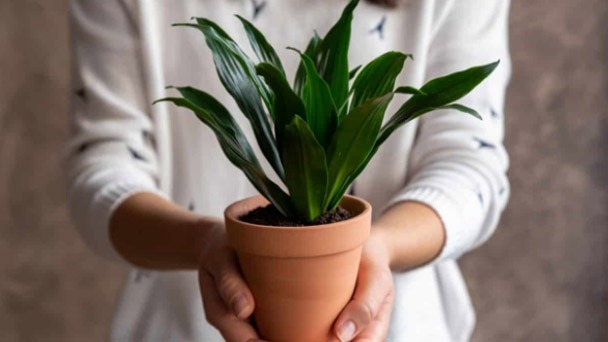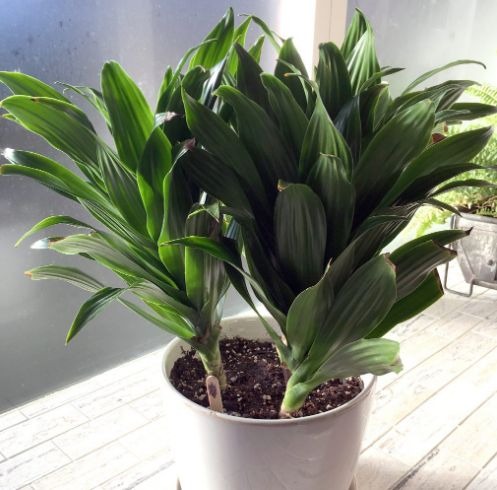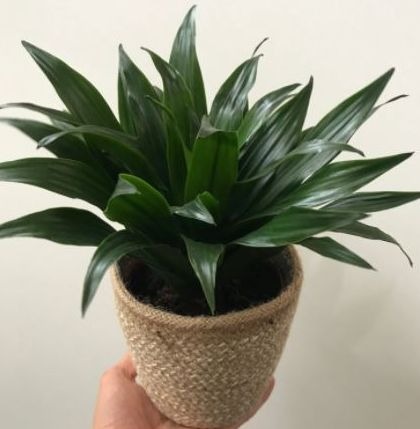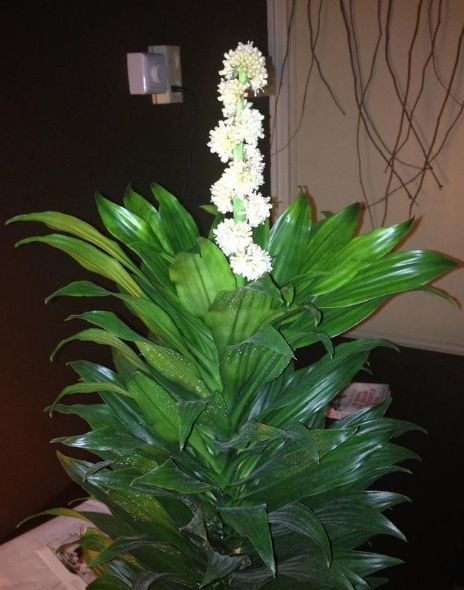How to Grow & Propagate Dracaena Janet Craig
Written by Ivy
Jan 10 2023

Dracaena Janet Craig is an interior workhorse that has been well-liked for decades. It is frequently used as a floor plant in interior settings or mass planted in beds. thrives in filtered light and endures low light levels.
Place them outside with some shade if you want to see its maximum growth. Be my guest; let's put them in a nice-looking pot to match their beautiful, mighty appearance if all you want them to be is the cutesy ornaments standing in the corner.
Dracaena Janet Craig Overview
| Scientific Name | Dracaena fragrans ‘Janet Craig' |
| Common Name | Janet Craig, Dracaena Janet Craig, corn plant |
| Light | Bright indirect sunlight |
| Watering | Water if the top half of the soil is dry |
| Temperature | 65 to 90ºF (18 to 32ºC) |
| Hardiness Zone | 10 to 12 |
| Humidity | 40 to 80% |
| Soil Type | Loose, quick-draining |
| Soil pH | 6.1 to 6.5 (mildly acidic) |
| Fertilizing | A balanced feed once every 3 months in spring and summer |
| Repotting | Every 2 to 3 years |
| Pruning | Beginning of the growing season |
| Propagation | Root in soil |
| Toxicity | Toxic to humans and pets |
| Mature Size | 4 to 6 feet as a houseplant |
| Bloom Time | Rarely blooms indoors |
Dracaena Janet Craig Description

Dracaena janet craig plants have sword- shaped, leathery, shiny dark green leaves that can be as large as 3" (7.6cm) wide and 10"- 20" (25cm – 50.8cm) long. When Dracaena janet craig is young, it looks good perched on a desk, table, or counter; as it grows older, either in bush or tree form, it can be used as a stately floor plant. A large Dracaena janet craig should have at least three stalks of varying heights; this will help to keep the plant bushy and full as it grows. In the right growing conditions, a Dracaena janet craig may produce tall, 10–12–inch (25.4–30.48–cm) stalks with big, fragrant white flowers. Although it's entertaining to watch, the flowers also produce a messy, sticky sap that gets on the ground, carpets, and nearby furniture. The flowers can even alter the attractive shape of the plant and slow down the growth of new leaves. As soon as they begin to appear, I like to stop them.
Dracaena Janet Craig Care
Light
Dracaena Janet Craig makes an excellent low-light indoor plant for an understory.
She has the makings of a very hardy indoor plant in most home environments when you combine her ability to withstand low humidity, air conditioning, and infrequent care.
Although it can survive in low light, filtered indirect light—not direct sunlight—is best for growing it. The room temperature that you feel most comfortable in is ideal for Janet Craig.
Temperatures
The cultivars of Dracena deremensis dislike heat. This is crucial to keep in mind, particularly in the summer when plants have a propensity to turn brown.
The suggested maximum temperature is 90 degrees Fahrenheit.
As temperatures rise above 95 degrees Fahrenheit, problems with leaf discoloration and leaves developing notching may occur.
Janet Craig is raised in deep shade in the nursery. This is not because the plants prefer low light.
More than lowering light levels, growers shade Janet's to regulate temperature.
Janet Craig doesn't grow much below 70 degrees Fahrenheit.
Around 35 degrees Fahrenheit or after a week of exposure to temperatures of 55 degrees Fahrenheit or lower, plants will suffer cold damage.
Watering
A potting soil with good drainage is required by Janet Craig. a blend of peat, pine bark, and perhaps 10% sand.
Because of the fluoride issues that can arise, avoid adding perlite to dracaenas. Dracaenas exhibit burnt or brown tips due to fluoride. Fluoride is great for teeth, but not for dracaenas.
Humidity
Basic indoor humidity levels are adequate.
The janet Craig dracaena has very high humidity requirements. All tropical plants were most dependent on the extremely high humidity. The optimal conditions you are providing to the plant will increase as the humidity level does.
The plant grows well and thrives easily when there is high humidity, which makes propagation for the following year or two easier. The plant can still live and grow if it is planted in an area with a medium level of humidity.
In contrast to tropical plants, which thrive in environments with higher humidity levels, there will be a huge difference.
Additionally, the low humidity is unsuitable for creating the ideal environment that a plant needs to survive and thrive. You can use any techniques and equipment that are already in your home or that you can purchase at the nearby garden supply store to ensure a constant and higher humidity level.
To raise the humidity level necessary for the plant, you can use a humidifier, a container with pebbles filled with water, mist, and other methods.
It's critical to keep in mind that the bathroom and living room consistently have higher humidity levels, which promote plant growth and provide natural home décor.
Flowering
A Dracaena janet craig may grow tall flower stalks with big, fragrant, white flowers if the growing conditions are ideal. The plant's shape is frequently ruined, leaf production is frequently slowed down, and the flowers frequently secrete a messy, sticky sap that gets all over the plant, the floor, and the furniture. I advise removing the flowers as soon as they emerge.
Pests
The main plant pests that can cause issues are mealy bugs and scale. Spray the leaves gently with the non-toxic Green Solution (recipe in the Glossary) before gently wiping them. It also gets rid of plant pests and dust accumulation.
Diseases
The main plant disease issue is called leaf spot. Where it is feeding on the leaves, the invading fungus or bacteria produces brown spots trimmed in yellow. The website's glossary has more information on Leaf Spot disease, including how to recognize and treat it.
Ideal Potting Mix
A very loose, well-draining soil with an excellent potting mix is required for the janet craig plant. A variety of organic materials, including peat moss, perlite, gravel, vermiculite humus, charcoal, etc., can be added to the soil.
To help the plant reach its ideal state for survival and growth, there should be a soil mix or potting mix.
However, not all of these ingredients can be used (organic ingredients may vary depending on availability). However, these organic components also assist the plant in avoiding becoming overly wet, which will eventually cause root rot.
Fertilizer
The organic kind of fertilizer is necessary for the janet Craig dracaena. The aforementioned fertilizer is capable of accelerating plant growth, providing all of the nutrition it needs, and addressing the plant's vitamin deficiency. For the plant to fully absorb the nutrients from the fertilizer, it might take some time.
Because the aforementioned fertilizer has no negative effects on the plant, I much prefer organic fertilizers for the care of Janet Craig Dracaenas. Additionally, organic fertilizers support healthy, nutrient-rich soil or potting mixes.
The best times to fertilize a plant are in the spring and summer. The plant also enjoys the benefits of spring and summer, when it can easily survive and flourish.
The best propagation seasons are at the same time during these seasons.
You should either avoid fertilizing the plant during the fall and winter, or only minimally do so. The Janet Craig dracaena typically slumbers or goes dormant during these times. Applying too much fertilizer to Janet Craig can cause the salt or other chemicals to stick, poisoning the plant.
Pot Size
Don't rush into re-potting a Dracaena janet craig because it prefers to be root-bound. Any new container must have drip holes in the bottom and should only be one size larger than the existing pot.
Potting & Repotting
Every two to three years, you'll most likely need to repot Janet Craig plants.
When roots begin to protrude from the drainage holes or curl around the pot's edges, it's time to repot Dracena Janet Craig.
You should never go up more than one or two sizes in terms of pots. Too much bare soil will keep the ground too wet, which can lead to root rot.
Your Janet Craig plant will thrive in an unglazed terra cotta container because it will help control the soil's moisture levels. Drainage holes are a necessity.
When repotting your Janet Craig plant, use fresh potting soil at all times.
Pruning
In the spring and early summer, prune dracaena janet craig plants with spindly or bare stems. Anywhere along the stalk of a cane, cut the top portion; below the cut, new leaves sprout. You can plant a new plant from the pruned section.
Early spring is a good time to cut Dracena Janet Craig. Simply cut it off at the desired height if it is too sparse and spindly for your taste.
Soon, fresh leaves will emerge from the bare stump, giving it a fuller, more compact appearance.
Naturally, whenever they appear throughout the year, you should remove any dead or damaged leaves.
However, if a Janet Craig plant leaf only has a little browning at the tip or along the margin, you can simply trim the tainted edges off with a pair of careful, sterilized scissors.
Propagation
Cuttings of Dracaena janet Craig do take root in water. However, using a 5 to 8 inch cane cutting is the preferred approach. In order to plant the cutting in the proper direction, take note of which end is top and which is bottom. Overnight exposure to the elements will help the cut end of the cane dry out. In a small pot filled with moist, extremely fine potting soil, place the cane cutting, and then place the pot in indirect light. If the soil seems especially dry over time, spritz it with a little water. The cuttings should root and produce new leaves in about 3 to 4 weeks.
Common Problems of Janet Craig Plant

If you've done your best to meet the Janet Craig plant's growing requirements, you shouldn't have too many problems with it, as you shouldn't with most houseplants.
Dracena Janet Craig can, however, occasionally cause issues that can be resolved without harming the plant.
The leaves will always be the first thing to alert you to a problem that needs to be solved.
Pests
If you carry out a small amount of preventative maintenance, you shouldn't have too many problems with Janet Craig plant pests.
You should be able to keep the majority of insects away by using an insecticidal soap or neem oil solution to wipe down the leaves of your Dracena Janet Craig once a month.
In addition to their webs, spider mites leave behind tiny yellow bumps on the leaves. It should be possible to get rid of them by taking your Janet Craig plant to the shower or sink and thoroughly rinsing the foliage.
Under the leaves, mealybugs will assemble into colonies that are white and fluffy. With a cotton ball soaked in rubbing alcohol, clean them off.
On the stems and leaves, scale insects will appear as brown, flat bumps. Scrape them away gently.
Diseases
If you are careful to follow the right watering procedures, you won't have to worry as much about Janet Craig plant diseases.
When exposed to excessive moisture, Dracena Janet Craig is vulnerable to bacterial and fungal diseases.
When your Janet Craig plant is overwatered, root rot is always a possibility.
The likelihood that the roots are beginning to turn black increases if the leaves begin to droop, turn yellow, and soften.
Remove any diseased parts, then replant the remaining parts in clean, new soil in a pot.
Wet leaves can become infected with a bacterial or fungal disease called leaf spot. Enhance airflow around your Janet Craig plant by removing all infected foliage.
Growing Problems
Simply put, failing to provide your Janet Craig plant with ideal growing conditions will lead to other growing issues.
But if you can make those components better, your sick plant ought to recover.
The soil may be too dry, the light may be too strong, or the humidity may be too low if the leaf tips are brown.
Curling leaves typically mean that the temperature is too low for your Janet Craig plant to tolerate.
When you use treated tap water, it is possible for the leaf margins to turn brown because this indicates high levels of salt and chlorine.
What's Unique About Janet Craig Plant?
The ancestors of the Janet Craig plant are indigenous to a sizable portion of tropical Africa, from Ethiopia to Zimbabwe and Mozambique to Guinea.
It's a variety of Dracaena Warneckii, found in the 1930s, and named after a Philadelphia nurseryman's daughter.
Long, glossy leaves and sturdy, thick central stems, which give Janet Craig plants their distinctive appearance of being miniature trees, are among their most distinctive features.
Janet Craig plant is one of the most hardy indoor plants, and it can thrive in almost any indoor environment, making it one of the easiest houseplants to grow. For novice growers, it works out perfectly.
The Janet Craig plant is not only beautiful, but also exceptional for its capacity to filter various indoor air pollutants.
Toxicity of Janet Craig Plant
Humans and dogs are only moderately toxic to dracona jane craig, but cats are susceptible to more severe side effects.
The saponin present in all plant parts, including the foliage of course, is what causes it to be toxic.
While small amounts of saponin can also be found in foods we eat, like spinach, larger amounts can have quite serious effects.
For Humans
The saponin found in foods like quinoa and chickpeas is safe for humans to consume in small amounts, but it can be harmful in large amounts.
High levels of saponins should be avoided because they can cause bloating, vomiting, and diarrhea that need to be treated right away.
Fortunately, the taste of a Janet Craig plant leaf is so bitter and unpleasant that even young children are unlikely to eat more than a small nibble.
However, it's best to instill in your children from a young age that this and all other houseplants are completely off-limits.
Even adults should exercise caution when working with Janet Craig plants because contact with the sap can cause dermatitis. After any exposure, give it a thorough rinse.
For Pets
All pets are at risk from plants that contain saponin, but cats are of particular concern.
If your cat or dog eats some foliage from a Janet Craig plant, you might notice general symptoms like vomiting, diarrhea, and excessive drooling.
Additionally, your cat might have dilated pupils.
Since cats are typically smaller than dogs, even a small amount of foliage could have detrimental effects. In extreme circumstances, the saponin can be fatal and can rupture blood cells.
Take your pet to the vet as soon as you can if it has consumed any foliage and is exhibiting any of these symptoms.

Conclusion
The leaves become burned by the sun, leaving unsightly brown marks or bleached spots. Too much fertilizer or using fluorinated, chlorinated, or salty water causes leaf tip burn
A Dracaena Janet Craig is a hardy plant that tolerates neglect well, grows slowly in low light, and is forgiving if you forget to water it. It's the perfect plant for someone missing a "green thumb" or a novice to caring for houseplants. Just keep in mind not to kill the plant kindly.
FAQs
How Quickly Do Dracaena Plants Grow?
Low light conditions cause Dracaena Janet Craig plants to grow very slowly, but bright indirect light conditions cause them to grow much faster. Always leave room for growth between the ceiling and the plant.
Are Dracaena Janet Craig Growth Rate?
Typically, "Janet Craig" dracaena plants grow at a medium to slow rate. This plant species grows more rapidly in bright light as long as it is shielded from direct sunlight. The houseplant dracaena "Janet Craig" is simple to grow but develops slowly in dim settings with little artificial light. Although low-light conditions are good for the health of the plant, moving the pot to a brighter area of your home will hasten its growth.
Is Dracaena Janet Craig Toxic to Animals?
Dogs and cats can become ill from dracaena plants. The plants' foliage contains toxic saponins, according to the ASPCA. After consuming plant fragments from the dracaena family, symptoms like vomiting, nausea, and excessive drooling may appear. If you want dracaenas to be indoor plants, pay your animals more attention and care.
Why Are the Tips of the Leaves on My Dracaena Janet Craig Turning Brown?
Using very fine, wet scissors, you can trim the leaves of your Dracaena Janet Craig. The cutting edges of the plant leaves don't turn yellow when they are cut with wet scissors. Brown tips on Dracaenas typically signify too much salt build-up in the soil as a result of overfertilizing or too much fluoride or chlorine in your water. Dracaenas only need to be fed in the spring and summer, not in the fall or winter. Never use water that has been softened because it is too salty.
How Do I Prune a Dracaena Janet Craig That is Touching the Ceiling?
Trim the stalks back to the desired height if your Dracaena janet craig is too tall. Think about the shape of the tree before you do any pruning because the plant will branch out, developing two or three new "heads" below each cut. The ends of the cane pieces you cut off can be dipped in a small amount of rooting hormone. For the purpose of starting a new plant, plant three or four of these stem fragments in potting soil.
How to Grow Janet Craig Plant Indoors?
The Janet Craig plant can be grown in a warm, moderately humid environment with regular watering and sparing feeding under natural or artificial lighting.
How to Grow Janet Craig Plant Outdoors?
In climate zones 10 to 12, the Janet Craig plant can be grown both in containers and the ground. Pots can be removed from the house in the summer in temperate zones.
Latest Updated
- Benefits of Bugleweed - 7 Science-backed Health Benefits
- Bugleweed Dangers & Side Effects - Is It Poisonous?
- How to Plant Evergreen Trees - What You Should Know
- When to Plant Evergreens - Grow Guide for Evergreen Trees
- 12 Wonderful Evergreen Shrubs for Your Garden
- 12 Popular Evergreen Plants with Pictures for Beginners
- When And How To Prune A Lilac Bush Like a Pro
- How to Grow & Care for Lilac Vine (Hardenbergia Violacea)
- Japanese Lilac Tree (Syringa Reticulata) Care & Propagation Guide
- Shumard Oak Pros and Cons - What to Know
Popular Articles
- Winter maintenance of Antirrhinum Majus
- How to Grow Terminalia Mantaly Tree
- How to Grow and Care for Crossostephium Chinense
- How to grow Antirrhinum Majus in spring
- Peristeria Elata (Dove Orchid) Profile: Info & Care Guide
- Underwatered Snake Plant (Sansevieria Trifasciata) - Signs And How To Fix
- How to Care for Brazilian Jasmine Plant (Mandevilla Sanderi)
- How to Grow & Care for Graptopetalum Purple Delight in Summer
- Rosa Chinensis (China Rose): Plant Growing & Care Tips
- How to Care for Baby Sun Rose (Aptenia Cordifolia)